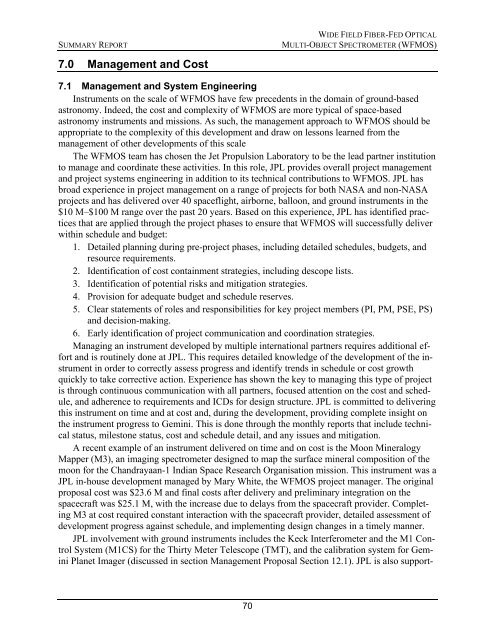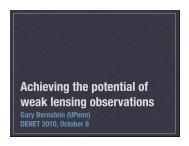STUDY SUMMARY - IPMU
STUDY SUMMARY - IPMU
STUDY SUMMARY - IPMU
Create successful ePaper yourself
Turn your PDF publications into a flip-book with our unique Google optimized e-Paper software.
<strong>SUMMARY</strong> REPORT<br />
WIDE FIELD FIBER-FED OPTICAL<br />
MULTI-OBJECT SPECTROMETER (WFMOS)<br />
7.0 Management and Cost<br />
7.1 Management and System Engineering<br />
Instruments on the scale of WFMOS have few precedents in the domain of ground-based<br />
astronomy. Indeed, the cost and complexity of WFMOS are more typical of space-based<br />
astronomy instruments and missions. As such, the management approach to WFMOS should be<br />
appropriate to the complexity of this development and draw on lessons learned from the<br />
management of other developments of this scale<br />
The WFMOS team has chosen the Jet Propulsion Laboratory to be the lead partner institution<br />
to manage and coordinate these activities. In this role, JPL provides overall project management<br />
and project systems engineering in addition to its technical contributions to WFMOS. JPL has<br />
broad experience in project management on a range of projects for both NASA and non-NASA<br />
projects and has delivered over 40 spaceflight, airborne, balloon, and ground instruments in the<br />
$10 M–$100 M range over the past 20 years. Based on this experience, JPL has identified practices<br />
that are applied through the project phases to ensure that WFMOS will successfully deliver<br />
within schedule and budget:<br />
1. Detailed planning during pre-project phases, including detailed schedules, budgets, and<br />
resource requirements.<br />
2. Identification of cost containment strategies, including descope lists.<br />
3. Identification of potential risks and mitigation strategies.<br />
4. Provision for adequate budget and schedule reserves.<br />
5. Clear statements of roles and responsibilities for key project members (PI, PM, PSE, PS)<br />
and decision-making.<br />
6. Early identification of project communication and coordination strategies.<br />
Managing an instrument developed by multiple international partners requires additional effort<br />
and is routinely done at JPL. This requires detailed knowledge of the development of the instrument<br />
in order to correctly assess progress and identify trends in schedule or cost growth<br />
quickly to take corrective action. Experience has shown the key to managing this type of project<br />
is through continuous communication with all partners, focused attention on the cost and schedule,<br />
and adherence to requirements and ICDs for design structure. JPL is committed to delivering<br />
this instrument on time and at cost and, during the development, providing complete insight on<br />
the instrument progress to Gemini. This is done through the monthly reports that include technical<br />
status, milestone status, cost and schedule detail, and any issues and mitigation.<br />
A recent example of an instrument delivered on time and on cost is the Moon Mineralogy<br />
Mapper (M3), an imaging spectrometer designed to map the surface mineral composition of the<br />
moon for the Chandrayaan-1 Indian Space Research Organisation mission. This instrument was a<br />
JPL in-house development managed by Mary White, the WFMOS project manager. The original<br />
proposal cost was $23.6 M and final costs after delivery and preliminary integration on the<br />
spacecraft was $25.1 M, with the increase due to delays from the spacecraft provider. Completing<br />
M3 at cost required constant interaction with the spacecraft provider, detailed assessment of<br />
development progress against schedule, and implementing design changes in a timely manner.<br />
JPL involvement with ground instruments includes the Keck Interferometer and the M1 Control<br />
System (M1CS) for the Thirty Meter Telescope (TMT), and the calibration system for Gemini<br />
Planet Imager (discussed in section Management Proposal Section 12.1). JPL is also support-<br />
70
















